|
 Descolea majestatica Descolea majestatica
BiostatusPresent in region - Indigenous. Endemic
Images (click to enlarge)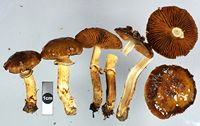
Owner: J.A. Cooper | 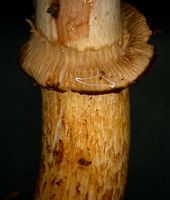
Caption: close up of ring. Note dark edge.
Owner: J.A. Cooper | 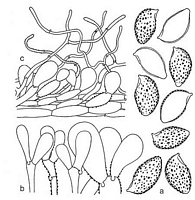
Caption: Fig. 5. Descolea majestatica. - a. Spores (2000 X). - b. Cheilocystidia (1000 x). - c. Cuticle
(500 X). | 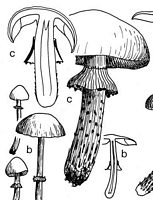
Caption: Descolea majestatica Horak, -Figs. 2c | 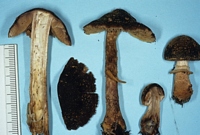
Owner: Herb. PDD | 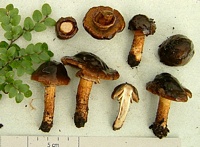
Owner: Karl Soop | 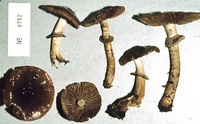
Caption: ZT0752
Owner: E. Horak: © Creative Commons Attribution-Noncommercial 3.0 New Zealand | 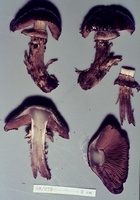
Caption: ZT68-272, Holotype
Owner: E. Horak: © Creative Commons Attribution-Noncommercial 3.0 New Zealand | 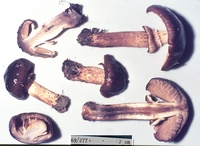
Caption: ZT69-277, Isotype
Owner: E. Horak: © Creative Commons Attribution-Noncommercial 3.0 New Zealand |
Article: Horak, E. (1971). Studies on the genus Descolea. Persoonia 6(2): 231-248.
Description: Pileus 30-70 mm diam., at first hemispherical with strongly incurved margin, becoming
umbonate-convex, rarely expanded, fleshy; dark (date) brown, always showing a distinct
olive-greenish tinge, hygrophanous; covered with a thick layer of slime (up to 3 mm), near
the striate margin grooved or wrinkled, without any squamulose remnants of the velum
universale. Lamellae emarginate, crowded; argillaceous to coffee brown or ochraceous-brown; gill edge whitish and fimbriate. Stipe 40-80 X 8-15 mm, cylindrical, robust, at
maturity fistulose; brown or lighter than the pileus; dry, apically glabrous to longitudinally
fibrillose, below the annulus with squarrose squamules; ring very conspicuous, pendent,
strongly striate, immobile; whitish or concolorous with the stipe; at the crenulate margin
frequently with brown, gelatinous patches (originating from the margin of the pileus).
Context brown. Smell and taste not distinctive. Spores 12.5-15 X 7-8 µ, almond-shaped,
strongly warted except for the mucro, with conspicuous perlspore embedding the warts,
plage smooth. Basidia 35-46 X 10-14 µ, 4-spored. Cystidia at the gill edge conspicuous,
25-60 X 10-35 µ, clavate, thin-walled, partially encrusted with brown pigment, with clamp
connections. Cuticle consisting of loosely arranged cells, 18-45 X 12-25 µ, more or less
forming an epithelium; membrane of hyphae strongly gelatinized and covered by crusts of a
brown pigment.
Habitat: HABITAT: Among litter in Nothofagus forests (N. cliffortioides, N. fusca, N.
menziesii). New Zealand.
Notes: Descolea majestatica, the third member of the genus with a gelatinized cuticle, is characterized
by several peculiarities which place it in a somewhat transitional taxonomic position. According to
the robust and fleshy nature of the fruiting bodies and the thick gelatinous layer on the pileus, this
species could be taken as related to Rozites. The latter genus is also known from the Nothofagus
forests of S. America, New Zealand, and Australia, and represented by some ten species. The
occurrence of articulate cheilocystidia and the generally amygdaliform spores brings out the close
relationship between D. majestatica and southern Rozites. The hymeniform cuticle, the smooth
mucro of the spores, and the strongly striate. persistent ring are however distinct characters of
Descolea. Therefore this species is considered to be a member of the genus Descolea.
|